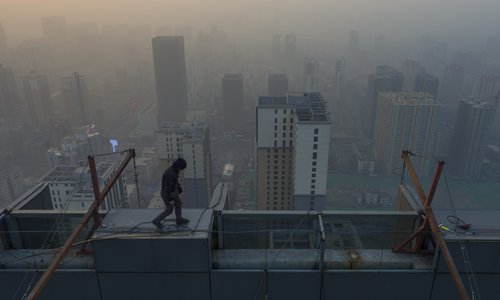
A view of Taiyuan, the capital of North China's Shanxi Province in 2019 Photo: VCG
At least 54 Chinese cities in northern areas of China have issued warnings of heavy air pollution recently, according to China's National Joint Research Center for Tackling Key Problems in Air Pollution Control (NAPC). Experts noted that unfavorable weather conditions, an increase in industrial activities, regional transmission and domestic heating have led to a thick haze in these cities.Beijing, Tianjin and cities in North China's Hebei and Shanxi provinces, East China's Shandong, and Northwest China's Shaanxi have been affected. The alert level in 47 cities has reached orange, the second-highest, and seven cities are on yellow level, the third-highest.
Chinese cities are taking various measures to curb emissions. Beijing, which started its yellow alert from Sunday, has ordered 368 companies in the city to stop or limit production amid the alert. It has also carried out environment inspections in key fields such as transportation and construction, the Beijing Daily reported Monday.
"The air looks bad and there seems to have been dust in the air in the last two to three days," a resident of Xi'an in Shaanxi told the Global Times on Monday, adding that the city has recently implemented rules requiring alternate driving days for cars with different license plate numbers in a bid to reduce emissions.
The Beijing-Tianjin-Hebei region and its surrounding areas saw air pollution from November 11 to 12 and experienced another round of pollution on November 14. The NAPC predicted that the second round would last until Tuesday.
The output of various major industrial firms in the region has increased compared to the same period last year, and pollutant emissions have increased correspondingly, the NAPC said in a Monday article, citing Wang Zifa, a member of the academic committee of the NAPC and also a researcher at the Institute of Atmospheric Physics of the Chinese Academy of Sciences.
Many cities in northern parts of China started domestic heating from early November, which has also aggravated the pollutant emissions, Wang said. In this context, heavy pollution is likely amid weather conditions of high humidity.

